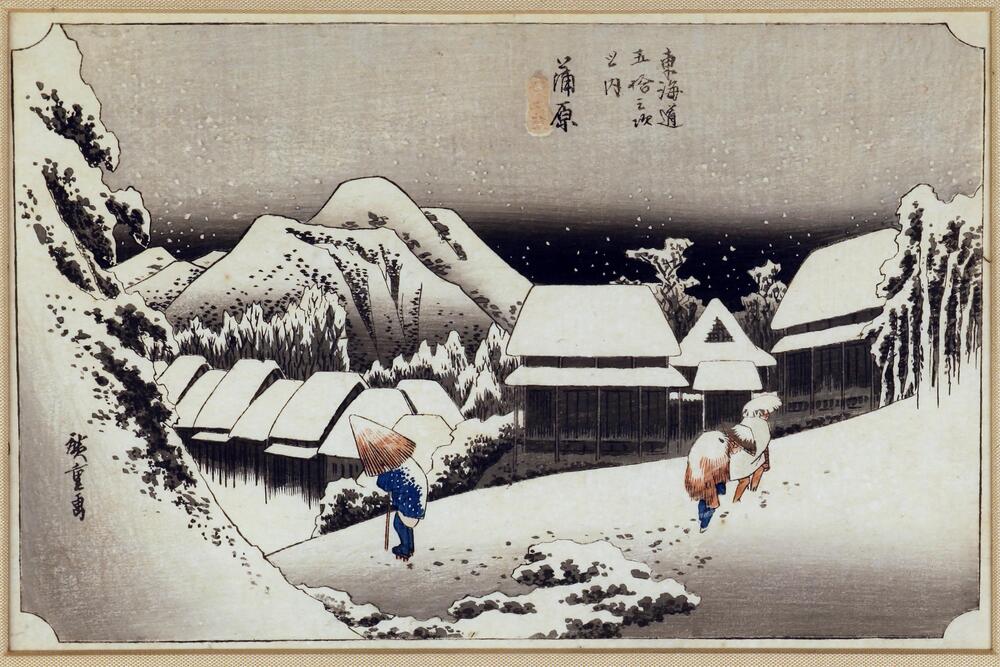Lesson Plan: Road Trip Memory Book
“Silk Road to Clipper Ship: Trade, Changing Markets, and East Asian Ceramics” and “Andô Hiroshige's 53 Stages of the Tôkaidô” UMMA Teacher Workshop Lesson created by Karen Koykka O’Neal
Objectives
Students will create a small book appropriate for several purposes. Students could use the book to display postcards documenting a trip, either actual postcards from a real trip or handmade postcards from an imagined trip. The handmade postcards could be created for various curricular units such as an art project, illustrating a story in a language arts class, or documenting an imagined trip to another culture in a social studies unit.
National Core Art Standards
- Organize and develop artistic ideas and work
- Develop and refine artistic work for presentation
- Relate artistic ideas and works with societal, cultural, and historical context to deepen understanding
- Social Studies: Geographic Perspective
- All students will describe, compare and explain the locations and characteristics of places, cultures and settlements.
- All students will describe, compare, and explain the locations and characteristics of ecosystems, resources, human adaptation, environmental impact, and the interrelationships among them.
Grades
2-8
Time Required
One class period to create book
Subsequent periods to add and annotate inclusions
Materials
- Cardboard, 2 pieces per student, 7” x 7” (this should be the weight of cereal box cardboard and will not be seen in final product)
- Paper, 2 pieces per student, 7” x 21” (good quality paper for the book binding)
- Paper, 1 piece per student, 7” x 28” (good quality paper for the book binding)
- Card stock or paper, 5 pieces per student, 7” x 14” (for book pages)
- Yarn, string or darning thread
- Darning needles
- Awl
- Photo corners or double sided tape
- http://www.readwritethink.org/files/resources/interactives/postcard/
Lesson
Making the binding – This could also be completed with thick paper instead of covered cardboard
- Place one piece of 7 x 21” paper in front of you vertically. Fold in thirds over 7 x 7” cardboard. The top and bottom will overlap completely, covering the cardboard. Fold the second piece of 7 x 21” paper around the second piece of cardboard in the same manner.
- Fold the 7 x 28” piece of paper in half. Open. With a bone folder, score another fold line 3/8" to 1/4" parallel to it. Spacing will depend on the thickness of the pages to be inserted. Place one piece of wrapped cardboard on the right side of the centerfold and one on the left side of the second scored line. Place these so that one open edge of each runs along the spine fold. Fold the right side of the paper over the cardboard. Do the same with the left side (the seam side of the wrapped cardboard should be down). Lift the far right edge of the 7 x 28” paper and slide it into the outer open edge of the wrapped cardboard that is closest to it. Repeat with the far left edge of the 7 x 28” paper.
Making the signature (the pages of the book) and assembling the book
- Stack 5 pieces of 7 x 14” paper on top of one another. Fold in half to make a 7” square. Open this stack, Using the awl, punch 3 holes through the entire thickness along the fold line, one in the center, and the other two about 1 inch from top and bottom edges. Stitch the signature together with the needles and yarn, string or thread, using the punched holes (pamphlet stitch). Because of the thickness of the folded pages, you may need to trim off a narrow strip along the edge, so that the pages are all the same size.
- Hold the first page of the signature and slide it under the right hand inner edge of wrapped cardboard at the center of the binding. Repeat with the last page of the signature, sliding it under the left hand inner edge.
Making the content
- Students may create or find a small collection of pictures of people in a cultural area you are studying in class (on the internet, in magazines). Pictures should feature geographical elements. Affix images with photocorners or double-sided tape.
- Discuss how the text might vary according to the function of the image. For example:
· Imagine this image is a postcard and you are sending it to a friend. What would you write?
· Imagine that you are going to summer camp at the location pictured here. What would be on the packing list?
· Imagine this picture is being used by a travel agency to entice people to travel here. How would the travel agents describe this area?
· Imagine you are in the Central Intelligence Agency. How would you advise military troops to travel through this area?
Alternative Process
Make digital postcards using an interactive online postcard maker such as:
http://www.readwritethink.org/files/resources/interactives/postcard/
This introduces students to the conventions of writing and mailing a physical postcard. You may then print and bind them using a similar stab-binding technique to that listed above.
Part of 1 Learning Collection
“Tradition Transformed: Chang Ku-nien Master Painte...
“Creative Literacies: Expanding our View,” UMMA Wor...
UMMA Exhibition, “The Graphic Dimension: Prints and...
“Creative Literacies: Expanding our View,” UMMA Wor...
“Teaching with Photography,” UMMA Workshop for Educ...
“Creative Literacies: Expanding our View,” UMMA Wor...
Lesson adapted from Educator Resources, Victoria & ...
“Benjamin West: General Wolfe and the Art of Empire...
“Creative Literacies: Expanding our View,” UMMA Wor...
“Teaching with Photography” UMMA Teacher Workshop,...
Lesson inspired by Elaine Wilson’s “Charting the Wo...
“Tradition Transformed: Chang Ku-nien Master Painte...
UMMA Teacher Workshop, “Xu Weixin: Monumental Portr...
“Teaching with Photography,” UMMA Workshop for Educ...
“Teaching with Landscape Photography,” UMMA Teacher...
UMMA Teacher Workshop, “Xu Weixin: Monumental Portr...
“Creative Literacies: Expanding our View,” UMMA Wor...
Rate this Resource
AVG: 0 | Ratings: 0
& Author Notes
Creative Commons by-nc-saLast Updated
March 6, 2017 1:19 a.m.Report
Reporting Policy

